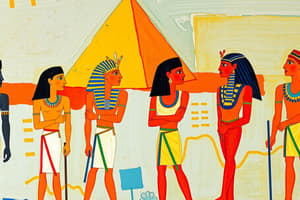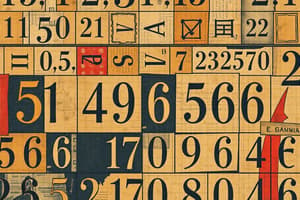Podcast
Questions and Answers
How did Egyptian scribes handle subtraction in their mathematical calculations?
How did Egyptian scribes handle subtraction in their mathematical calculations?
- By memorizing subtraction tables for quick reference.
- By converting numbers to hieratic symbols for easier calculations.
- By replacing symbols with ten of the next lower symbol when 'borrowing' was needed. (correct)
- By utilizing a complex algorithm involving multiple steps.
What was the unique feature of the Egyptian algorithm for addition and subtraction mentioned in the text?
What was the unique feature of the Egyptian algorithm for addition and subtraction mentioned in the text?
- The conversion of symbols to hieratic numbers.
- The implementation of a simple algorithm involving symbol doubling. (correct)
- The use of complex symbols for basic math operations.
- The memorization of extensive addition and subtraction tables.
How did Egyptian scribes approach multiplication according to the text?
How did Egyptian scribes approach multiplication according to the text?
- By applying a complex division algorithm.
- By memorizing multiplication tables up to a certain extent.
- By using a continual doubling process in their calculations. (correct)
- By converting numbers directly into hieratic symbols.
What did Egyptian scribes do when the next doubling would cause the first element of the pair to exceed the desired number?
What did Egyptian scribes do when the next doubling would cause the first element of the pair to exceed the desired number?
What marks a significant difference between Egyptian mathematics and the hieratic system in terms of addition and subtraction?
What marks a significant difference between Egyptian mathematics and the hieratic system in terms of addition and subtraction?
Why did Egyptian scribes stop the multiplication process when the first element of the pair exceeded a certain value?
Why did Egyptian scribes stop the multiplication process when the first element of the pair exceeded a certain value?
What did Egyptian scribes do after determining the powers of 2 that add to a number in multiplication?
What did Egyptian scribes do after determining the powers of 2 that add to a number in multiplication?
What was significant about the Egyptian algorithm for addition and subtraction compared to that in the hieratic system?
What was significant about the Egyptian algorithm for addition and subtraction compared to that in the hieratic system?
What could be inferred about Egyptian scribes from their approach to multiplication based on the text?
What could be inferred about Egyptian scribes from their approach to multiplication based on the text?
How did Egyptian scribes determine which multipliers to use in multiplication based on the text?
How did Egyptian scribes determine which multipliers to use in multiplication based on the text?
What was a notable limitation of the hieratic system when compared to how Egyptian scribes handled mathematical operations?
What was a notable limitation of the hieratic system when compared to how Egyptian scribes handled mathematical operations?
Flashcards
Egyptian subtraction
Egyptian subtraction
They replaced symbols with ten of the next lower symbol when 'borrowing' was needed.
Egyptian addition/subtraction algorithm
Egyptian addition/subtraction algorithm
It involves a simple algorithm of doubling symbols.
Egyptian multiplication
Egyptian multiplication
Egyptian scribes used a continual doubling process.
Stopping the doubling process
Stopping the doubling process
Signup and view all the flashcards
Hieratic system's limitation
Hieratic system's limitation
Signup and view all the flashcards
Reason to stop multiplication process
Reason to stop multiplication process
Signup and view all the flashcards
Final step in Egyptian multiplication
Final step in Egyptian multiplication
Signup and view all the flashcards
Egyptian algorithm significance
Egyptian algorithm significance
Signup and view all the flashcards
Egyptian Scribes
Egyptian Scribes
Signup and view all the flashcards
Selecting multipliers
Selecting multipliers
Signup and view all the flashcards
Limitation of hieratic system
Limitation of hieratic system
Signup and view all the flashcards
Study Notes
Egyptian Numerals
- Egyptian numerals were written with smaller digits on the left.
- The hieratic system had specific symbols for numbers 1 to 9, multiples of 10 from 10 to 90, and multiples of 100 from 100 to 900.
- Examples of hieratic symbols: 7 = , 30 = , 3 = , 40 = , 200 = .
Writing Numbers
- To write a number, symbols were combined; for example, 37 was written as .
- The Egyptians had a zero symbol, but it was not used in mathematical papyri.
Computation Algorithms
- Addition and subtraction were simple: combine units, tens, hundreds, and so on, replacing groups of ten with the next symbol.
- For example, adding 783 and 275: + = .
Division and Fractions
- Division was the inverse of multiplication; for example, 156 ÷ 12 was solved by finding the sum of powers of 2 that equals 156.
- Fractions were represented as unit fractions (1/n) or "parts," with the exception of 2/3.
- The fraction 1/n was represented by the symbol for n with a symbol above it.
Multiplication
- The Egyptian algorithm for multiplication was based on a continual doubling process.
- To multiply a and b, a scribe would write down the pair 1, b, double each number, and stop when the next doubling would exceed a.
- The powers of 2 that add to a were determined, and the corresponding multiples of b were added to get the answer.
Studying That Suits You
Use AI to generate personalized quizzes and flashcards to suit your learning preferences.



